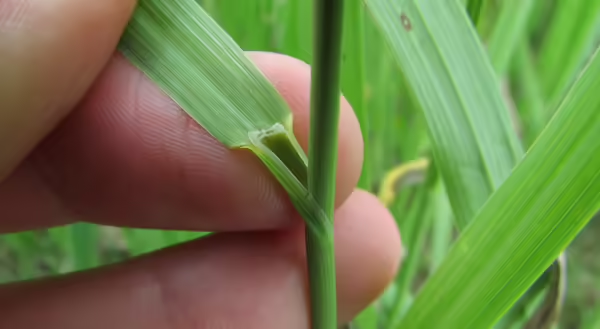
What do you see when you look at a grass? Green leaves in a bunch? The cause of your allergies? A plant that constantly needs to be mowed?
Grasses do not invite easy identification. They are missing the number one useful identification feature – a colorful flower! But that’s not to say that they don’t flower, because they do. But more on that in a future post.
Where should we start with grass identification? For now, let’s focus on the vegetative parts of a grass. This includes the leaves and stem. There are a few features that we can look for that will provide helpful clues to telling what type of grass you are looking at.

Let’s start with the stem
The stem, also called the culm, is the backbone of the grass. What should you pay attention to on the stem? In general, grass stems are round – that’s one of the diagnostic features that separates it from sedges, which are other grass-like plants. Grass stems can be hairy, with short bristly hairs or long smooth hairs, or they can be smooth and hairless. Sometimes the stem can have a whitish powder on it, making it look cloudy. Stems with this white powder are called glaucous. Stems can also vary in color – they can be green, red, brown, or purplish.
Taking a closer look at leaves
You are probably familiar with grass leaves, but you may not have known that they have three parts. Grass leaves include a blade – which is typically the part we think of as the leaf; a sheath, which is a continuation of the leaf blade that wraps around the stem; and a node, which I like to think of as the kneecap of the grass. Nodes occur at the base of the leaf sheath and are swellings that look like joints. Leaf sheaths can be wrapped tightly or loosely – and can therefore be characterized as “closed” or “open.”
Leaves vary in texture, shape, and color. When leaves senesce (die), they can curl in distinctive ways that help with identification. Leaves can have a thick white vein down the middle or be green throughout. Paying attention to the shape, color, and texture of leaves will be an important skill.
Another important spot for grass identification is the place where the leaf blade becomes the sheath. We call this the collar region, and there are structures located here that are essential in plant identification. These include ligules, auricles, and horns.

Ligules: a hidden characteristic
One of the first things I look for when identifying a grass is a structure called a ligule. Ligules can be found in the collar region. When you pull the leaf blade away from the stem, you may see either a membrane or a collection of hairs – this is a ligule.
The absence or presence of a ligule, as well as what type you see, are very helpful characteristics to make note of. Membranous ligules look white early in the growing season, but turn yellow, brown, or orange with age. They can be tall (or easy to see) or very short (sometimes requiring a hand lens). Ligules can also be collections of hairs – which can be short and stiff or tall and silky. If a ligule is not present, look for an upside-down horseshoe-shaped smooth surface.

Less common characteristics
Some grasses, such as the ryes, have an extra feature called auricles. I like to think of auricles as little arms that extend from the base of the leaf blade and wrap around, or hug, the stem. If a grass has auricles, when you pull back the leaf blade you should see them unwrap and open.
Finally, one last feature to look for are horns. Horns are stiff, u-shaped plant material in the collar region. Indiangrass is a grass with horns.
We’ll stop here for today – when you look a grass now, try to see if the stem has hairs or white powder, pay attention to the shape and texture of the leaves, and look for a ligule, auricles, or horns. What do you see?
Never miss a new post! Sign up for our email list.
ABOUT THE AUTHOR: Erin Garrett is a Natural Resources, Environment, and Energy Educator for University of Illinois Extension serving Alexander, Johnson, Massac, Pulaski, and Union counties. Erin develops and delivers high impact programming to adults and youth to help them develop an appreciation for natural resources and to empower them to make small changes to positively impact the environment. Erin’s programming focuses on why homeowners should consider choosing native plants, how to support native pollinators, how to identify grasses, how to identify and manage invasive species, and developing an appreciation for prairie ecosystems.
ABOUT THE BLOG: Grasses at a Glance dives into grass identification, focusing on tips and tricks that make grass identification possible. Get information about native and non-native species, how to tell look-alikes apart, and which grasses you can find in Illinois.